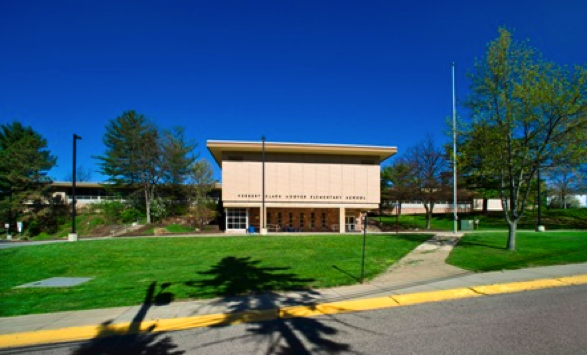

Progressive Public Elementary School: Cooperative Learning & UDL
Herbert Clark Hoover Elementary School was an unusual place in so many ways. It had a suspended staircase in the center of two modern era buildings with a fish pond underneath with real live koi swimming in it! We were organized not in classrooms by grade level, but "complexes," consisting of a mix of kids in either the first, second and third grades (which were called lower, middle and upper primary students) or, in my case, fourth, fifth and six graders. We were called lower, middle and upper intermediate students. There were no school plays because competition was discouraged. Helping each other learn and understand was the name of the game. Bullies were non-existent in my complex. I definitely preferred this to my other schools.
There were no letter grades, only "Performs successfully" and "Experiencing difficulty," designations across a long list of evaluations. Spelling was never counted against you and all students were given calculators when they reached a certain level of math (around the fifth grade). We had a choice of what literature classic we wanted to read. Our teacher was so passionate about this program, she bought the books with her own money.
We were often given choices of how we wanted to do our assignments. We could create works of art, write poems, and chose what books we wanted to read during Silent Reading period (yes, including comic books, which were A-OK). Silent Reading was twice a week, alternating with Oral Reading period, during which our teacher read aloud to us.
Math class was self-paced and involved taking pre-tests for each chapter, meeting one-on-one with the teacher to have your test corrected and to receive an assignment from the chapter based on your assessment. Even though I had come a few months after the semester started, by December, I was in the second highest math group consisting of three fifth graders - I mean "Middles" and two "Upper Intermediates" (sixth graders). It was fun to go at my own pace.
Attending this school put me into the Advanced Accelerated math program in our district which meant I was two years ahead of the regular track, instead of just one (Advanced). My senior year, I could've taken math classes at Carnegie-Mellon University two afternoons a week, but it would've precluded me from taking other necessary classes. Instead, I took two years of calculus. In our math classes we were encouraged to meet in problem solving groups, which apparently, was modeled after an educational practice used in Europe.
Being lucky enough to experience such a wonderful learning environment as I did at my school district made me want to share these concepts and this generous attitude about learning with other people. After college, I started working for PBS, where knowledge could be made available to all people, in a way that was accessible to everyone. This often meant adding compelling visuals and audio to interviews we'd conduct with experts.
Years later, I was told by an education professor that I should check out Harvard's Graduate School of Education. When I visited the department, I had the strange feeling that I was home again. Students were respected and their love of learning was fostered and encouraged. I can't explain how, but it felt like there was a lot of psychology mixed in with the process of learning. In my conversations with faculty and students there, I was told to talk to a professor named Dr. Rose about his work with Universal Design for Learning.
A few years later, I was reading an article on my old principal, Dr. Davidson, who by now, had passed away. It helped me to track down a friend of hers. When I spoke to her on the phone, she mentioned Dr. Davidson had taught at Harvard many of her summers. It was a wonderful discovery. I felt like I had come full circle. Perhaps Dr. Davidson had been employing concepts at Hoover Elementary that she had discovered at Harvard. I'll never know for sure, but there's no question I consider myself truly blessed to have been a lucky beneficiary of Universal Design for Learning.
SO MANY ELEMENTARY SCHOOLS
SO LITTLE TIME
Public School Stigmatizing
UDL ENCOURAGES DIVERSITY
AND CAN HELP PREVENT ATYPICAL LEARNERS FROM BEING STIGMATIZED
My family moved around a lot when I was a child because of my father's work. As a result, I got to experience learning at several different elementary schools by the time I was 12. At that point, my parents settled us into a neighborhood that had one of the best public school systems in the country.
All the schools I attended had unique and wonderful elements. But, I also got to experience first-hand how certain practices could create indelible feelings of stigma for students, especially those with learning differences.
When I was six, my family moved from Pittsburgh, Pennsylvania to a small town in Ohio called Ashtabula, which means, "always enough fish to go around" in one dialect of the Algoniquian tribe. Ashtabulans pronounced some of their vowel combinations vastly differently than where I was raised. In Pennsylvania, we say the word "root" so that it rhymes with "mute," and "creek" so it rhymes with "leek," for example.
Folks in Ohio, however, pronounced "root" so it rhymed with "put," and "creek" so it rhymed with "brick." Huh?
I was immediately singled out by my first grade teacher, Mrs. Dilly (yes, that was her name) and, even though I was never told this directly, I felt I was branded "learning disabled." Every few days, a resource person would pull me out of the classroom, make me sit at a desk in the hallway right outside my classroom door, so I could hear all the "normal" kids learning their lessons. Here I sat, at a desk pushed out into a drafty atrium, its dull white linoleum tiles steaked with gray muddy water tracked in on our winter boots. In this academic purgatory, I was taught about exotic creatures called "dipthongs" and the correct way to pronounce words with double vowel combinations.
When I was inside the classroom, Mrs. Dilly would make fun of the fact I spent too much time finishing my coloring projects, pointing my slowness out to the rest of the class. This was a big change from my previous school in Pennsylvania, where my teacher lauded my "creative" and artistic abilities. I think I was an odd kid, so perhaps her assessment was generous. The fact remained, however, that school went from being a wonderful, fun exploration, to something I dreaded and made me feel deeply and troublingly ashamed.
Thankfully, my dad's job shifted again making it necessary to move away from there.
No amount of fish would have made me want to stay.
I was an unwitting fan of Universal Design for Learning (UDL) long before I had heard of the name for it.
Universal Design for Learning is the idea that good design is accessible and beneficial to everyone, whether or not they may have learning or perceptual challenges, disabilities or other factors that might single them out from the general population. You can read more about it by clicking the Universal Design tab.
Below is another blog entry exploring my journeys with UDL.
Parochial School: Structure & Competition
After a year and half in Ohio, we moved back to Pennsylvania, where I got to experience the wonders of parochial school. Here, everything was controlled and regimented. We said prayers, had spelling bees, diagrammed sentences, and students' desks were rearranged every week based on how well they did on the math test. I did adequately well in this environment, although I did have my head batted back and forth by the butt of Sister Macrina's hand a few times for wasting paper.
It was a working class neighborhood, and many of the kids were tough. They seemed to enjoy name calling and bullying, practices I didn't understand the point or the choreography of. Fortunately, I had blonde hair, which seemed to be something special back then, so people generally left me alone. I was also tall, which might've also helped, and I did find myself intervening on the behalf of other kids from time to time. One student was Mary Jane Aspen, who had a kidney problem and apparently smelled bad (not that I noticed). I did not understand why making fun of someone was considered recreation at this school, but I seemed to exist more or less outside it. One day, the girls decided they'd keep Mary Jane on the playground, making her late coming in from lunch at her designated time, and setting her up for certain punishment by the nuns.
In an effort to block her path, ten girls clasped hands and spread out in in a line, to form of a human chain. But, there was a flaw with this plan. One of the kids in this human blockade comprised of little girls, was Amy Hofstetter, who was uncategorically a nice girl. I grabbed Mary Jane's hand and walked right up to the chain, determined to break through by force if necessary. Thankflly, I spied Amy, who was in my path, and kept forging ahead. I stopped before her, Mary Jane in tow, and looked resolutely into Amy's eyes.
Amy's facial expression didn't change, but I remember noticing her hand as it dropped to her side.
The inpenetrable chain had been broken.
It was therefore a shock when in the fifth grade, I was called to the principal's office. I was a goodie-two-shoes who spent the time before school began praying with the Stations of the Cross in the big old church adjacent to the education buildings. I was secretly thrilled, and my curiosity peaked, that I might've unwittingly committed some wrong doing, and become suddenly "de rigeur," like the popular mean kids.
My mother was waiting in the principal's office. Oh boy. This must really be bad. But of course, it didn't turn out to be as exciting a summons as I had imagined. I guess I had performed well on a standardized test, putting me at a 13th grade reading level and a respectable math level as well. The reading score would've been my mother's doing. She surrounded us with books and was always reading to us or encouraging us to read. Diagramming sentences probably didn't hurt either.
Sister Jane Katherine (our principal) recommended that my mother send me to an all-girl's Catholic academy and boarding school. Thankfully, we moved to Mt. Lebanon instead, a suburb with fine public schools and an extremely cutting edge, progressive elementary school led by a visionary principal, Dr. Shirley Davidson.
